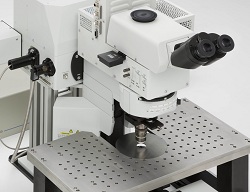MAKING use of every photon that a sample emits under fluorescence imaging is increasingly important in advanced life science research, says Olympus Europa, introducing its new FV10MP-BXD-GAP photodetector. This non-descanned unit can capture very faint fluorescence signals and so minimise the laser power needed to illuminate a sample, the company says.
Lower laser power, of course, reduces the effects of phototoxicity and photobleaching on delicate biological samples – particularly important when imaging over long time periods with multiple exposures, such as when creating time-lapse videos of microscopic specimens.
The secret to the detector’s sensitivity is the use of gallium arsenide phosphide (GaAsP) surface coating, which is said to offer much better quantum efficiency that conventional photomultiplier tubes (PMTs). In fact, the photodetector assembly includes both the GaAsP and PMT detecors, allowing scientists to scan initially to find areas of interest with the PMT, and then home in to see the faintest traces of fluorescence using the high-sensitivity GaAsP detector. This approach maximses the life of the GaAsP detector.
The FV10MP-BXD-GAP detector is available as part of the Olympus FluoView FV1000MPE multiphoton microscope, or can be purchased to upgrade an existing instrument. Either way, Olympus says the extreme sensitivity will enable researchers to gain new insights from their images, unhampered by low laser power or very faint fluorophores.

